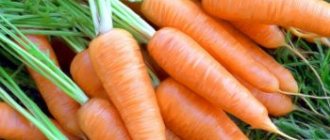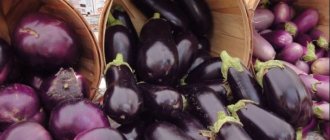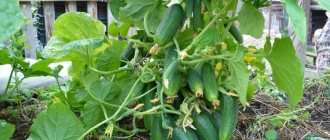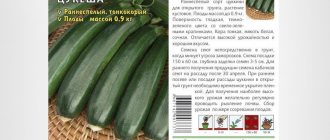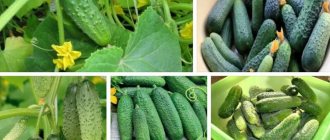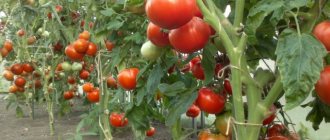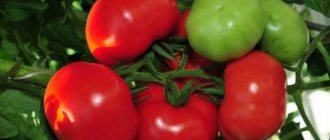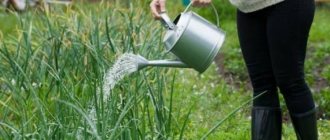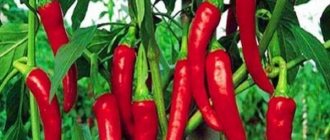Vegetable growing » Pumpkin
3
1081
Article rating
Kira Stoletova
Unlike the climbing pumpkin, the bush pumpkin does not spread long shoots and does not spread along the ground. Many people grow it to save space. Some care steps required for climbing species are omitted, making cultivation easier. Varieties of this pumpkin are characterized by the fact that you do not have to wait long for its harvest. The fruits are mostly small.
The best varieties of bush pumpkins
General description of bush pumpkin
Bush pumpkin is a small, compact plant that is suitable for small garden plots. The stems of the crop are erect, there are no vines, pumpkins are formed at the very base. Size, color and shape depend on the variety, but they have one similarity - early fruiting. After planting the seeds and before harvesting, no more than 3.5 months pass. There are no late-ripening varieties of bush pumpkin, so it does not have time to ripen in regions with an unstable climate.
When choosing the best variety of bush pumpkin, you need to take into account weather conditions, soil quality and growing habits.
The following bush pumpkin varieties are suitable for Siberia:
- Freckle - spherical-flattened fruits weighing up to 3 kg, ripen 90 days after the sprouts appear. The pumpkins are emerald green with numerous yellow spots. The pulp is juicy, aromatic, sweet with a fruity flavor.
- Adagio - flattened fruits weighing up to 3 kg ripen 3 months after planting the seeds. The pulp is sugary, juicy and aromatic. Adagio is a dietary product, so it is used in children's menus.
Popular cold-resistant varieties of bush pumpkin for the Urals:
- Dachnaya is an early ripening plant with fruits weighing up to 4 kg. Green pumpkins with yellow stripes have a good taste and aroma. Productivity and keeping quality are good, the harvest is suitable for preparing baby food.
- Golden - rounded-flattened vegetables, weighing up to 5 kg, appear 90 days after planting the seeds. Thanks to the golden skin of pumpkins, the plants look decorative. The pulp is yellow, crispy, with low sugar content.
The following varieties of bush pumpkin are suitable for cultivation in the Moscow region:
- Nutmeg is a compact vegetable that is grown only through seedlings. The spherical fruits have a good taste with a slight nutmeg aroma.
- Aport is the most popular variety. He gained fame for his excellent taste and unpretentiousness. Round-flattened pumpkins, weighing up to 7 kg, have very sweet, crispy, juicy pulp. Thanks to the smooth, dense peel, the crop has good shelf life and high transportability.
Farmer reviews
Orange bush is a godsend for summer residents . Here's what gardeners from all over Russia say about the variety:
Maria, Moscow : “The orange bush attracts me with its appearance. Large fruits look beautiful both in the garden and on the table. I cook pumpkin dishes in the oven and add them to milk porridge.”
Pavel, Rostov-on-Don : “This variety is one of my favorites. The taste is moderately sweet, the flesh is pleasant. A rich harvest always grows. For example, last year I collected 15 kg.”
Irina, Samara : “I planted the Orange Bush in the greenhouse. A week after planting, I noticed small bugs - slugs - behind the sprouts. We managed to get rid of them, but with difficulty. I think I’ll grow other varieties.”
Benefits of growing bush pumpkin
Bush pumpkin has become very popular among gardeners. This is due to the following factors:
- compact bush that does not require formation;
- suitable for small garden plots;
- dense foliage retains moisture and protects the plant from drying out;
- high fruiting;
- precocity;
- ease of care;
- frost resistance;
- good taste and harvest;
- the pulp will contain a large percentage of carotene and microelements.
Despite the large number of positive factors, gardeners have identified some minor disadvantages:
- most varieties have dense skin;
- Not all fruits are sweet and aromatic enough.
The best varieties of bush pumpkin for open ground
When choosing a variety, you must first analyze all the main characteristics and select the most suitable one for cultivation. What to pay attention to:
- ripening time;
- cold resistance;
- taste and external qualities;
- peel thickness;
- keeping quality and transportability;
- productivity.
Orange
Bush pumpkin Orange, according to gardeners, is a mid-season variety. Ripening occurs 3 months after planting the seeds. Due to its high cold resistance, Orange pumpkin is suitable for growing in Siberia. But in order to wait for the harvest, it is recommended to grow Orange pumpkin in seedlings.
Important! Scheme for planting seedlings in open ground 60x60 cm.
The vegetable, weighing up to 5 kg, is colored bright orange and has a spherical-flattened shape. The pulp is bright yellow, juicy, moderately sweet and aromatic. Due to their low sugar content, the fruits are used for making soups, vegetable stews, baby food and canned food for the winter.
Advice! Before purchasing an Orange bush pumpkin, you must read the description and view the photo.
Golden
Getting acquainted with the Golden bush pumpkin must begin with a description and varietal characteristics. The plant is mid-season, ripening occurs 110 days after seed germination. Forms a compact, low-climbing bush. The fruits are flattened, spherical in shape, weighing up to 5 kg. Golden skin with snow-white veins, medium density. The bright lemon pulp is sweet, crisp and juicy.
Thanks to frost and drought resistance, it can be grown throughout Russia. But, according to reviews from gardeners, in order to get an early harvest, it is better to plant Golden pumpkin using seedlings. The crop bears fruit well on nutritious soil, the planting pattern is 70x70 cm. Subject to agrotechnical rules, fruiting is high from 1 sq. m you can remove up to 15 kg.
Amazon
Amazon refers to bush, compact, mid-season varieties. Harvesting occurs 110 days after planting. The flattened vegetables are orange in color with snow-white stripes. A harvest weighing no more than 2 kg has good presentation and shelf life. The taste is high. The orange flesh is sweet, crisp and very aromatic.
Amazon bush pumpkin is not a cold-resistant species, so it is recommended to grow it only in regions with warm climates. Planting pattern – 150x150 cm.
Important! The Amazon shelf life is 4 months, and the crop does not lose its taste, aroma or presentation.
Sweet early
Bush pumpkin Early sweet or sweet pie refers to early-ripening, table varieties. To grow fruits weighing up to 3 kg, it will take no more than 3 months. The pulp of the orange-red vegetable is soft and crispy, the peel is thin but dense. The plant is universal, suitable for making preserves, juices, and soups. To get a high and stable harvest, the bush must be given proper care, which includes watering, fertilizing and loosening the soil.
hundred pound
Hundred Pumpkin is a large-fruited, mid-late variety. Ripening occurs 140 days after seed germination. The variety produces fruits weighing 10-20 kg.
Fruits with thin, orange peel can have a spherical or oval shape. The pulp is loose, low in sugar, not aromatic. Due to the lack of a strong taste and aroma, pumpkin is used in the agricultural industry; the ripe crop is often used as livestock feed.
Important! Good fruiting can only be achieved when grown on nutritious soil and in regions with a moderately warm climate.
Rouge Vif Detamp
Rouge Vif Detamp was bred by French breeders and is one of the 10 popular varieties of bush pumpkin among Russian gardeners. The plant is loved for its compact size, good taste, and high yield. If agrotechnical rules are followed, pumpkins grow up to 10 kg or more. Universal use, the crop is suitable for making soups, sauces, juices and preserving for the winter. In regions with a harsh climate, it is not recommended to grow the variety, as it will not have time to fully ripen. Due to its low-sugar pulp, the fruits are recommended for use by children, diabetics and people on a diet.
Smile
Smile is a large-fruited pumpkin with early ripening. The plant is cold-resistant and bears fruit well even with sudden changes in temperature and humidity. Thanks to these indicators, the Smile pumpkin can be grown in Siberia and the Urals. The bright orange fruits are loved for their very sweet and aromatic pulp.
The plant forms a compact, low bush with large light emerald leaves. Thanks to the dense foliage, the soil does not dry out and retains moisture for a long time.
Hybrid Smile prefers to grow in a well-lit place, at a distance of 80 cm from each other. To keep the fruits juicy and sweet, watering is carried out as the soil dries, and the plant is fed once every 15 days with organic and mineral fertilizers.
Medical
Medicinal is an early ripening table variety. The plant forms a small, compact bush. The thin skin of the flattened fruits is dark ash-colored with an unusual dark gray mesh pattern. The bright orange pulp is juicy, crisp and flavorful. The variety retains its taste, presentation and freshness for up to 1 year.
Medicinal bush pumpkin has the disadvantage of weak immunity to fungal diseases. If agrotechnical rules are not followed, the following are attached to the plant:
- powdery mildew;
- anthracnose;
- white and gray rot.
Important! Due to its high frost resistance, Medicinal pumpkin can be grown in all regions of Russia.
Pearl
Pearl belongs to the muscat pumpkin varieties. It is recommended to grow it in central Russia. The plant forms about 6 shoots, each forming 1 ovary. The plant is early ripening, harvesting occurs 100 days after planting the seeds.
Ripe fruits, weighing up to 7 kg, have a cylindrical shape and a bright orange color. Pumpkin has a high shelf life, but due to its thin peel it can suffer mechanical damage during long-term transportation. Thanks to its high yield, Zhemchuzhina is grown not only on a personal plot, but also on an industrial scale.
Gribovskaya
Gribovskaya pumpkin is an old, popular hybrid bred by Soviet breeders. It is widely known among Siberian and Ural gardeners, as it can withstand sudden changes in temperature and humidity and produces a stable, abundant harvest, despite the weather. To obtain an early harvest, the variety is recommended to be grown in seedlings.
The bush form produces elongated fruits weighing up to 5 kg. The thick, orange peel with dark green stripes protects the juicy and sweet pulp during long-term transportation. Due to its high sugar content, the harvest is used to make jam, juices and a variety of desserts.
Fruiting is early, the first pumpkins appear 80 days after the sprouts appear. If the crop does not have time to ripen in the garden, then the unripe crop will ripen safely during storage.
Gribovskaya bush pumpkin has strong immunity to powdery mildew and bacteriosis.
Basal
Bush pumpkin Prikornevaya was bred by Krasnodar scientists and in 1980 received permission for cultivation in the North Caucasus and Far Eastern regions.
The plant forms a small bush, the fruits are formed next to the root collar. The bush is covered with large, heart-shaped leaves, thanks to which the soil remains moist for a long time.
Bush pumpkin Basal is an early ripening variety. No more than 110 days pass from sowing seeds to harvesting. Fruits weighing 5-10 kg are colored light gray. The bright orange pulp is dense and juicy.
Lel
The Lel variety is an early pumpkin crop. In regions with a warm, favorable climate, the first fruits appear already in mid-summer. They have a medium-flattened, ribbed surface, painted in a light ash color with pronounced brown stripes. The pulp is juicy and dense. But, despite their juiciness, the fruits are not used in cooking, but are used for the green conveyor belt.
Lel has strong immunity to powdery mildew, anthracnose and downy mildew. The variety is famous for its creamy seeds, which contain up to 50% fat. Medicines, oils, infusions and tinctures are prepared from them.
Barnaul
Barnaul - refers to the mid-season bush varieties of pumpkin. The plant forms a small leafy bush and cylindrical fruits, weighing up to 5 kg, ash-colored. The plant is resistant to fungal diseases and sudden temperature changes, and bears fruit well in regions with cold, short summers. Due to its varietal characteristics, the plant is suitable for cultivation in Siberia and the Urals.
The pulp of the fruit is dense, juicy, and medium sugary. The harvest is suitable for freezing, preparing preparations, vegetable stews and dietary dishes.
Roll
Pumpkin Valok belongs to large-fruited, table, and bush varieties. Gray fruits, weighing up to 10 kg, are formed at the root collar. The variety is mid-season, oilseed and fodder. Ripening occurs on the 110th day after emergence.
The shape of the fruit, weighing up to 8 kg, is spherical. The gray peel is smooth, slightly segmented. The taste is mediocre, but the juice made from the harvest is very healthy. The vegetable contains:
- dry matter – 7%;
- sugar – 4.1%;
- carotene – 2.1 mg.
Bush pumpkin Valok cannot be stored for long periods of time and cannot be transported, so it is not recommended to be grown on an industrial scale.
Crocus
Large-fruited variety, bred by Soviet scientists. It was entered into the State Register in 1998 and is permitted for cultivation in the North Caucasus and Lower Volga regions. The variety is valued for its good transportability and ability to withstand temperatures down to -1-2 °C.
The plant produces fruits weighing up to 5 kg. The pulp is juicy, sweet and aromatic. Crocus is resistant to leaf bacteriosis, but is often infected with powdery mildew. Therefore, when growing this variety, it is necessary to follow agrotechnical rules and carry out preventive measures.
The variety is universal. It is used for making juice, sauces, preparations and preserves.
Honey beauty
A popular bush pumpkin variety imported from China. It is early ripening, ripening occurs 3 months after planting the seeds. Fruit varietal characteristics:
- spherical shape;
- orange peel color with pronounced green spots;
- weight up to 6 kg;
- thin but dense peel;
- the seeds have a high fat content;
- crispy, juicy, aromatic pulp;
- versatility in use.
Honey beauty is subject to long-term storage, and it can withstand long-term transportation.
Freckle
An early ripening variety of bush pumpkin. Due to its cold resistance, the plant is suitable for growing in Siberia and the Urals. Green fruits with variegated spots ripen 100 days after planting. The pumpkin pulp is juicy, soft, with a delicate pear aroma.
Freckle is highly productive, so it is recommended for cultivation on an industrial scale. To obtain the long-awaited harvest, timely care is required, which consists of watering, fertilizing and loosening the soil.
Thanks to its juicy, aromatic and beautiful pulp, the fruits look original in winter preparations, vegetable salads and as a side dish for meat and fish.
Important! The dense peel allows the harvest to be stored for about 1 year, while the fruits do not lose their taste, freshness and aroma.
Harvesting and application
The Bush Orange crop is harvested in August-September , when the fruits are covered with a hard crust and acquire a dark orange color. Pumpkins are picked along with the stem.
After harvesting, the vegetables are not washed, but wiped with a dry cloth: this way the crop will retain its freshness, taste and benefits longer. Store the fruits in a cellar or basement. The optimal humidity level is 80%.
Pumpkin is added to nutritious puree soups, vegetable salads, casseroles and snacks . Low-calorie and healthy desserts are made from the pulp of Bush Orange: cakes, muffins, cheesecakes, mousses and sorbets. Enhance the taste of the product with mint, cinnamon or honey.
Interesting! 100 g of pumpkin contains more protein than 100 g of quail eggs. In terms of the amount of carotene, pumpkin overtook carrots by 5 times.
Features of growing bush pumpkin
In order for the pumpkin to produce a good harvest, it is necessary to follow simple agrotechnical rules.
- Planting – bush pumpkin prefers to grow in a sunny area with fertile soil.
- Planting material must undergo pre-sowing preparation before planting.
- Abundant irrigation is carried out during flowering and fruiting. The water should be settled and at room temperature. Watering is stopped 30 days before harvest.
- The soil must be well fertilized before planting seeds.
- If the summer is rainy, then artificial pollination is carried out.

